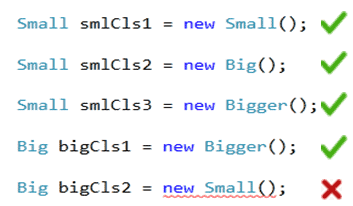C# 菜鸟教程
- C# 教程
- C# 版本历史
- C# 入门程序
- C# 基本语法
- C# 关键字
- C# 数据类型
- C# 类型转换
- C# 变量
- C# 常量
- C# var
- C# 数字类型(Number)
- C# 字符串(String)
- C# 日期和时间
- C# 值类型和引用类型
- C# 匿名类型
- C# 动态类型(Dynamic)
- C# 类(Class)
- C# 接口(Interface)
- C# 运算符
- C# If 条件语句
- C# 三元运算符
- C# Switch 语句
- C# for 循环
- C# while 循环
- C# do...while 循环
- C# 结构体(Struct)
- C# 枚举(Enum)
- C# StringBuilder
- C# 分部类和方法(Partial)
- C# 静态(Static)
- C# 数组(Array)
- C# 索引器(Indexer)
- C# 泛型
- C# Tuple(元组)
- C# ValueTuple(值元组)
- C# 异常类(Exception)
- C# 异常处理
- C# 委托(Delegate)
- C# 事件(Event)
- C# 匿名方法
- C# 可空类型(Nullable)
- C# 扩展方法
- C# 流(Stream)
- C# 文件和目录
- C# 对象初始化器
- C# FileInfo
C# 高级教程
C# 面向对象(OOP)
C# 协变和逆变
协变和逆变使我们在处理类层次结构时更加灵活。
在学习协变和逆变之前,请看以下类层次结构:
public class Small
{
}
public class Big: Small
{
}
public class Bigger : Big
{
}根据上面的示例类,Small 是 Big 的基类,而Big 是 Bigger 的基类。这里要记住的一点是,派生类将始终具有比基类更多的东西,因此基类比派生类要小。
现在,看以下初始化:

如上所示,基类可以容纳派生类,但派生类不能容纳基类。换句话说,一个实例即使要求很小也可以接受大,但是如果要求很大就不能接受小。
现在,让我们了解协变和逆变。
C# 协变(Covariance)
协变使您能够传递派生类型,其中需要基类型。协变就像同类型的方差。基类和其他派生类被认为是向基类型添加额外功能的同类类。因此,协变允许您在需要基类的地方使用派生类(如果需要小类,则 rule: 可以接受大类)。
协变可以应用于委托,泛型,数组,接口等。
委托协变
委托中的协变允许委托方法的返回类型具有灵活性。
public delegate Small covarDel(Big mc);
public class Program
{
public static Big Method1(Big bg)
{
Console.WriteLine("Method1");
return new Big();
}
public static Small Method2(Big bg)
{
Console.WriteLine("Method2");
return new Small();
}
public static void Main(string[] args)
{
covarDel del = Method1;
Small sm1 = del(new Big());
del= Method2;
Small sm2 = del(new Big());
}
}输出:
Method1 Method2
如您在上面的示例中看到的那样,委托期望返回的类型为 Small(基类),但是我们仍然可以分配返回Big(派生类)的Method1以及具有与委托期望的签名相同的Method2。
因此,协变允许您将方法分配给具有较少派生返回类型的委托。
C# 逆变 (Contravariane)
将Contravariane(逆变)应用于参数。 Cotravariance(逆变) 允许将基类参数分配给希望派生类参数的委托的方法。
继续上面的示例,添加具有与委托不同的参数类型的Method3:
delegate Small covarDel(Big mc);
class Program
{
static Big Method1(Big bg)
{
Console.WriteLine("Method1");
return new Big();
}
static Small Method2(Big bg)
{
Console.WriteLine("Method2");
return new Small();
}
static Small Method3(Small sml)
{
Console.WriteLine("Method3");
return new Small();
}
static void Main(string[] args)
{
covarDel del = Method1;
del += Method2;
del += Method3;
Small sm = del(new Big());
}输出:
Method1 Method2 Method3
如您看到的,Method3具有Small类的参数,而委托则期望Big类的参数。 不过,您可以将Method3与委托一起使用。
您还可以按如下所示的相同方法使用协变和逆变。
示例:协变和逆变的使用
delegate Small covarDel(Big mc);class Program
{ static Big Method4(Small sml)
{ Console.WriteLine("Method3");
return new Big();
} static void Main(string[] args)
{ covarDel del = Method4;
Small sm = del(new Big());
}
}输出:
Method4